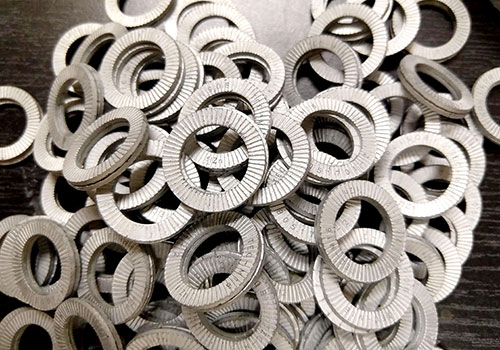The History of the Wedge-Locking Washer – An ingenious Fastening Solution proved to solve the issue of self-loosening of Fasteners under joint movement or dynamic loading conditions
- Wedge Locking Washers
- October 30, 2023


The use of traditional flat washers dates back many centuries and was thought to be originally designed to try and reduce the wear and tear on bolted joints and has been developed into different forms to try and improve the bolted joint performance.
Many devices have been developed over the years to try and solve the phenomenon known as Self-loosening which is when a bolted joint simply un-tightens over time which is caused by dynamic loading and the bolt not having enough pre-load to prevent this from happening.
Most of the devices developed such as spring washers, conical washers, wave washers, tab washers, nylon inserted nuts and prevailing torque nuts all provide some form of reducing the self-loosening effect but do not 100% guarantee it will prevent it.
The wedge lock washer, also commonly referred to as a Nord-Lock washer, was invented in the 1950s by a Swedish engineer named Rune Wingquist.
The understanding of why bolted joints self-loosen and what makes this happen was starting to be understood more in 1969 when German Engineer Gerhard Junker developed the test criteria DIN 65151 which was then developed more recently into DIN 25201. You can read more about this by clicking here or watching this video here.
It was not until 1982 when the Swedish Company Nobex acquired the Patent for Wedge-Locking Washers and started manufacturing them under the Nord-Lock Brand that the Wedge Locking Washer design started to be commercialised.
Design and Mechanism:
The Wedge-Locking Washer is a two-part design that has hardened radial teeth to both outside edges and smooth cams faces to the middle that meet and lock. The smoothness of cam faces compared to the radial teeth that bite into the bolt/nut head and substrate means that when the joint tries to come loose it does so through the CAM faces.
The clever part of the design is that the CAM faces have an angle that is steeper than the pitch of the thread, this means that when the washers try to separate the design actually slightly increases the tension in the joint and maintains it.
Unlike Friction-based products, the Wedge-Locking washer maintains the joint by using tension and the only way to undo the joint is by physically applying an un-tightening force meaning the system combats the self-loosening of fasteners over time.
There are quite a few videos on YouTube explaining how it works which are quite useful to watch, see one from Nord Lock here and one from us here.
Applications and Advantages:
The Wedge Locking Washer is available in sizes as small as M3 and as large as M120 as standard so the applications are vast across many sectors. Please visit our page Sectors by clicking here where the many applications for Wedge Locking Washers are explained.
The main principle of where they are used is for Fasteners that are used in critical joints that can not afford to come loose for function or Safety and where the tension in the joint needs to be maintained at all times.
The fact that the product uses tension and not friction provides the advantage that the threaded parts can be lubricated to improve the consistency in within the load in the joint.
It also means that the product can be installed very quickly and easily like a normal washer and does not rely on friction like other products that grip to the thread meaning that they are slow to install and damage the thread on removal.
The Wedge Washer Today
In terms of Nuts and Bolts the Wedge Locking Washer also referred to by many people who have become familiar with the product as a Nord Lock washer it is a relatively new concept and has only been commercially available since 1982.
The product has been used extensively across many applications and when it is used to solve a problem it is often the start of a new application that will never be changed.
It is still not something that is explained as standard in Engineering Universities and Colleges and is something that manufacturers such as ourselves are trying to help within the education system.
It seems that you have the people that have come across the Technology and will refer to them as Nord-Lock washers if they have used the Nord Lock version or they will call them Wedge Washers for example if they use ours and really, they should be saying Wedge Locking washers tested to DIN 25201.
The long-term aim is to move the History on and to make people know the standard DIN 25201 for the testing related to dynamic loading and that a Wedge Locking Washer is one of the only products that will maintain the pre-load in a bolted joint for when the designer has any concerns for safety that the bolt may self-loosen. See more videos on subjects like pre-load on our YouTube Channel here



